- Home
- Golden Hour
Capturing Magical Wildlife Moments: Tips for Golden Hour Photography
Have you ever been wowed by those stunning nature photos bathed in a warm, golden light that seems to highlight every detail perfectly?
That's the magic of golden hour photography, a special time when the sun is low on the horizon, wrapping everything in a warm, glowing light that can turn even the simplest scenes into breathtaking views.
If you're wondering if it's worth it to wake up early or stay out in the evening to catch this magical light, the answer is definitely yes.
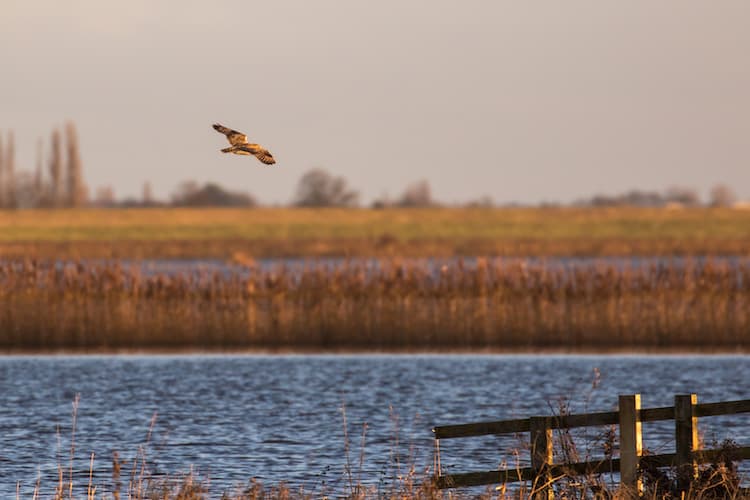 Short Eared Owl
Short Eared OwlThe soft, gentle light reduces harsh shadows, making everything look its best, from sweeping landscapes to intimate wildlife portraits. The warm tones and long shadows add depth and drama to your photos, making them truly stand out.
But the benefits of golden hour photography go beyond just beautiful light. This special time of day brings nature to life, with wildlife on the move, offering unique moments for incredible shots.
In this post, we're going to explore the charm of golden hour photography and give you some handy tips for planning, shooting, and editing your photos to capture nature and wildlife in all its glory.
Plan Ahead for Success
The golden hour truly is a photographer's dream, but capturing its magic takes a bit of planning and preparation.
Many photographers miss out on this incredible light simply because they don't know when and where to be ready for it.
The good news is, with a little forethought and some basic knowledge, you can consistently find yourself in the right place at the right time to take advantage of this fleeting window of opportunity.
The main challenge with golden hour photography is that the ideal conditions only last for a brief period – around an hour after sunrise and an hour before sunset.
The key is being prepared and in position well before the golden hour begins, so you don't miss a moment of that magical light.
Use Planning Apps
To ensure you're in the right place at the right time, you can use mobile apps like The Photographer's Ephemeris.
These tools provide sunrise and sunset times for specific locations, allowing you to time your shoots perfectly and make the most of the golden hour's brief window of opportunity.
Scout Locations and Arrive Early
Scouting locations beforehand is essential, so don't just show up during the golden hour and hope for the best.
Instead, take the time to explore the area during daylight hours, identifying potential obstacles and pinpointing the best vantage points.
You can also tap into the expertise of local guides or photographers who have spent years honing their craft in the area. By asking questions and learning from their experiences, you'll be able to plan your shot with precision and avoid any last-minute surprises.
Once you've scouted and planned, arrive at your location well before sunrise to beat the crowds and ensure you're in position and set up before the golden hour begins.
This extra effort will pay off in images that will leave viewers in awe of the breathtaking scenes you've captured.
Dedication and planning paid off
It's not always easy to prioritize photography over a good night's sleep, especially when traveling with others. But sometimes, it's necessary to take a quiet moment for yourself to pursue your passion.
I recall a trip to Bamburgh, Northumberland, where I seized the opportunity to capture the golden hour.
While my companions slept, I rose early, slipping out of our cottage to take a peaceful stroll down the coastal road. The street lights guided me safely through the darkness as I navigated past Grace Darling's burial church and finally reached the narrow street that I discovered the day before would lead me to the beach.
There, I met a fellow photographer, both of us seeking to capture the dawn's golden light. Fortunately, we had ample space to set up our gear without obstructing each other's shots.
As I reached the water's edge, I turned to face inland, and my perseverance was rewarded. The golden light danced across Bamburgh Castle, its beauty mirrored in the nearby saltwater pools.
I had timed it perfectly, capturing the stunning scene in all its golden hour glory.
Although the extra four-mile walk left my feet sore by the end of the day, the experience was well worth the effort.
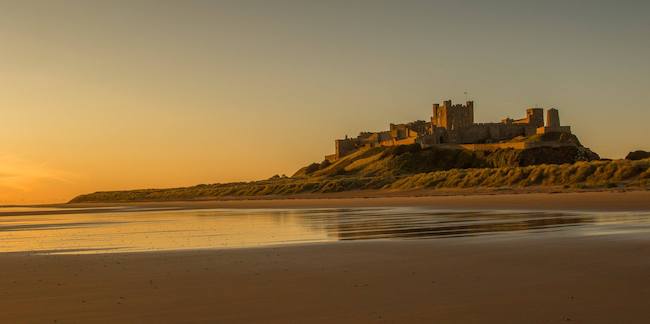 Bamburgh Castle at sunrise
Bamburgh Castle at sunriseDon't give up!
Things don't always go as planned.
We've experienced it firsthand at Spurn Point, a narrow spit of land between the North Sea and the Humber mudflats, in East Yorkshire, England.
Torrential rain and gale force winds are not conducive to getting out with the camera!
It took us four days to capture the perfect storm of sunrise light, ideal weather, and the wading birds in the right place.
Keep in mind that partly cloudy skies can actually enhance the golden hour effect. The clouds act as a natural reflector and diffuser, amplifying the warm, low-angle sunlight and creating a more dramatic and colourful scene.
So, be on the lookout for these conditions to add an extra layer of depth to your photographs.
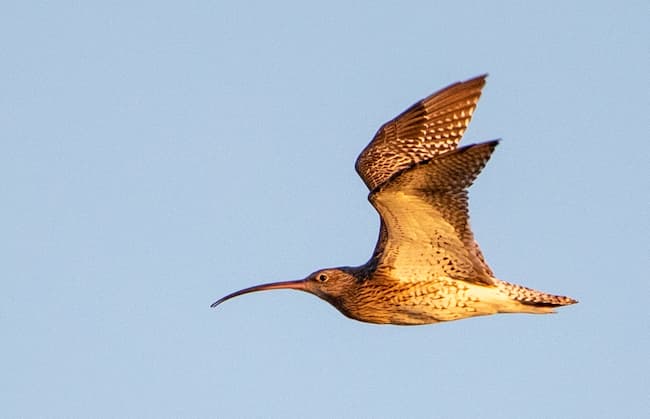 Curlew flying during Golden Hour over the Humber
Curlew flying during Golden Hour over the HumberTechniques for Stunning Golden Hour Shots
With your planning and preparation in place, it's time to focus on the techniques that will help you capture stunning golden hour shots.
The unique lighting conditions of this magical time of day require a thoughtful approach to make the most of the warm, soft tones and dramatic shadows.
To make the most of the situation you'll need a few key techniques in your toolkit.
These include…
- controlling depth of field to emphasise your subject,
- exposing for the highlights to capture the full range of tones,
- and shooting in RAW for greater editing flexibility.
Additionally, incorporating foreground elements will add depth to your images, while experimenting with silhouettes and backlighting will create dramatic, high-impact shots.
By embracing the warm, golden hues that define this time of day, you'll be able to transport your viewers directly into the breathtaking scenes you witnessed.
Whether you're a seasoned photographer or just starting out, these techniques will provide you with the tools you need to capture the beauty and drama of nature's fleeting moments, creating images that truly stand out and leave a lasting impression.
Depth of Field Control for Captivating Golden Hour Shots
One of the most effective techniques for drawing attention to your subject during this magical time is controlling depth of field.
By carefully adjusting your aperture, you can create a shallow depth of field that isolates your main subject against a beautifully blurred background, making it stand out amidst the warm, glowing light.
In wildlife portraits, this technique is particularly effective, as it allows you to emphasize the animal's eyes or distinctive features.
- Imagine capturing a majestic stag silhouetted against the rising sun, its antlers perfectly defined while the surrounding foliage melts into a dreamy, golden bokeh.
- Similarly, a delicate wildflower can be transformed into a stunning image, with its petals seemingly illuminated from within and the background dissolving into a soft, radiant haze.
To use this technique, it's necessary to understand how aperture affects depth of field.
A wider aperture (such as f/2.8 or f/4) will create a shallower depth of field, allowing you to isolate your subject with precision.
Conversely, a narrower aperture (like f/16 or f/22) will increase the depth of field, bringing more of the scene into sharp focus – ideal for sweeping landscapes or scenes with multiple points of interest.
By intentionally controlling the depth of field during the golden hour, you'll be able to direct the viewer's eye exactly where you want it, creating images that are not only technically stunning but also emotionally compelling.
This powerful technique, combined with the warm, flattering light of this magical time of day, will elevate your photography to new heights and allow you to capture the true essence of nature's fleeting moments.
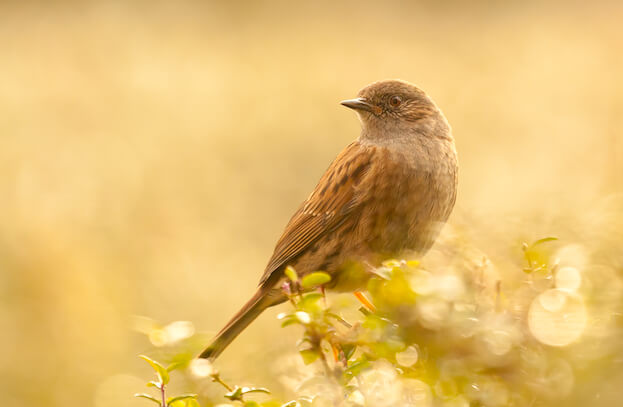 A wide aperture threw the background of this Dunnock out of focus
A wide aperture threw the background of this Dunnock out of focusExposure: Balancing the Extremes of Golden Hour Light
As we've discussed, the golden hour offers a unique opportunity to capture breathtaking images.
However, nailing the exposure is necessary to preserve the delicate details and saturated colours.
During the golden hour, the dynamic range of light can be challenging, with bright highlights and deep shadows vying for attention.
To master golden hour exposure, it's essential to understand your camera's capabilities and employ the right techniques to balance the scene's extremes.
This may involve using exposure compensation to avoid underexposing your subject against a bright background or switching to spot metering to ensure you're exposing for the areas you want to prioritize.
In some cases, taking full manual control and bracketing your exposures may be necessary to capture the full range of tones and preserve those breathtaking highlights.
By dedicating time to understanding and mastering exposure during the golden hour, you'll be able to capture the true essence of this magical time, preserving every warm, glowing detail and creating images that transport your viewers to the heart of the moment.
Remember, experimenting with different settings and techniques is key to achieving the perfect exposure, so don't be afraid to try new approaches to bring out the best in your golden hour shots.
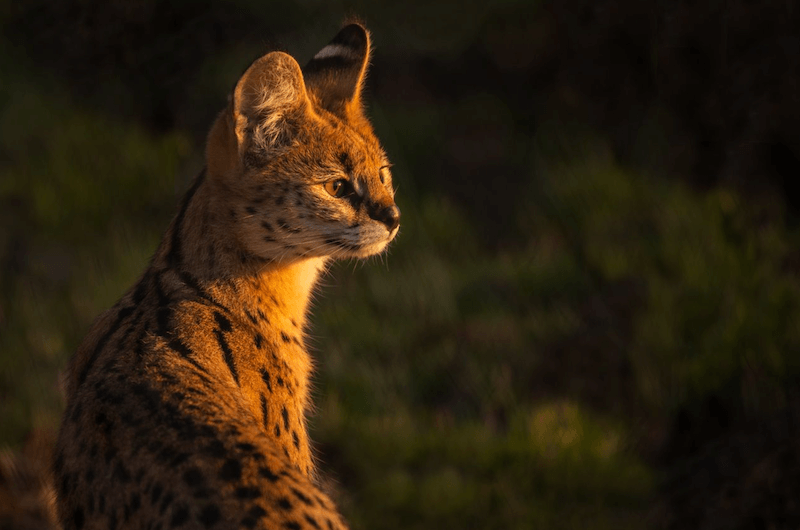 A zoo photo, but it demonstrates keeping detail in the highlights (taken at sunset)
A zoo photo, but it demonstrates keeping detail in the highlights (taken at sunset)Shooting in RAW: The Full Potential of Golden Hour Photography
In the challenging lighting conditions of golden hour, where bright sunlight and deep shadows coexist, capturing maximum dynamic range is essential.
It can mean the difference between a good shot and a truly breathtaking one.
RAW format provides the freedom to reveal details that would be lost in a compressed JPEG file.
By opting for RAW, you preserve every detail captured by your camera’s sensor. This detail is crucial for fine-tuning white balance and achieving the warm tones and highlights that caught your eye initially.
Although not all cameras have RAW capabilities and it requires specific software, the effort significantly enhances golden hour photography.
With this level of control, you can do justice to the breathtaking scenes witnessed during those fleeting moments of magical light.
If new to photography, check out my page on camera settings to learn more about apertures and shutter speeds.
Or use this interactive camera settings widget, below.
Select the scene you're shooting to get started:
Editing Your Golden Hour Photos
The golden hour provides excellent lighting for photography, but sometimes your photos may need additional editing to fully showcase their beauty. In this section, we offer insights and practical tips for enhancing your photos during post-processing.
Whether you're an experienced photographer or a beginner, mastering editing skills for golden hour photography is helpful. Editing not only helps correct imperfections but also allows you to express your creativity.
We will cover essential techniques such as adjusting white balance to amplify golden tones, using dodge and burn to focus on your subject, and employing sharpening methods for a final touch.
Adjusting White Balance for Golden Hour Perfection
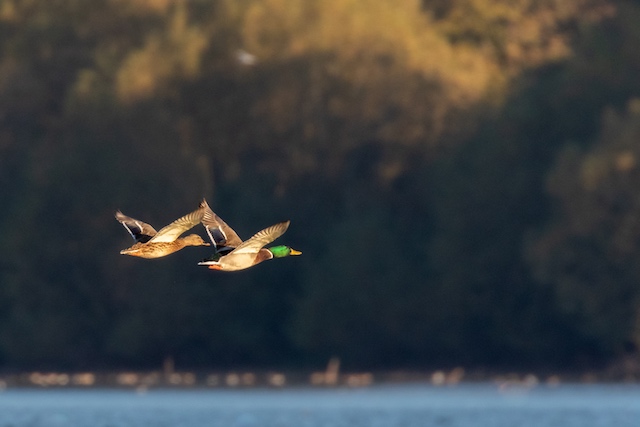 A pair of Mallard highlighted by the golden hour light
A pair of Mallard highlighted by the golden hour lightOne of the most critical aspects of editing your golden hour photos is adjusting the white balance to amplify those gorgeous golden tones.
If you forgot to set the white balance during shooting, don't worry – it's not a disaster, especially if you were shooting in RAW.
In post-processing, you can make subtle adjustments to dial in those rich, dreamy tones that are characteristic of the golden hour.
In photo editing software like Lightroom or Photoshop, intuitive sliders enable you to make subtle adjustments. The goal is to strike a delicate balance, not to make the photo so warm that it turns bright orange.
By mastering this technique, you'll be able to represent the essence of the golden hour's ephemeral beauty and create images that inspire a sense of awe and wonder.
Enhancing Golden Hour Images with Dodging and Burning
The golden hour's soft, warm light is a photographer's dream, but even the most stunning scenes can benefit from selective editing to draw the viewer's eye exactly where you want it.
This is where the timeless techniques of dodging and burning come into play.
By learning these skills, you'll be able to add a level of refinement to your golden hour shots, subtly guiding the viewer's focus and bringing out the details that matter most.
Whether you want to highlight the intricate textures of a gnarled tree trunk in a landscape shot or make the subject's eyes pop against a warm, glowing backdrop in a wildlife portrait, dodging and burning will give you the control you need to take your images from beautiful to truly breathtaking.
Enhancing Golden Hour Images with Sharpening
The golden hour photographs you've meticulously planned, framed, and exposed deserve the perfect finishing touch to make them truly shine.
This is where sharpening comes into play, enabling you to bring out the finest details and textures.
Whether you're aiming to accentuate the delicate veins of a leaf, the rugged bark of an ancient tree, or the intricate feather patterns of a bird, sharpening will help you achieve a level of clarity and crispness that draws the viewer in and immerses them in the scene.
To successfully sharpen your images, it's essential to strike the right balance.
Too little, and your images may appear soft or lacking in definition; too much, and you risk introducing unsightly halos or artifacts.
We'll guide you through the process, sharing tips and techniques for sharpening in both Lightroom and Photoshop, ensuring you can apply the perfect amount of sharpening to your golden hour masterpieces.
Putting it all into Practice
I know it's not easy to get up early, especially when your bed is so cozy.
However, capturing the golden hour is rewarding. Imagine transporting viewers into a world bathed in the soft, magical glow of dawn or dusk.
With the techniques shared here, you can create stunning images that leave a lasting impression.
So, take a deep breath, set your alarm clock a bit earlier, and prepare to chase the golden hour.
The results will make your heart skip a beat and inspire others.
What are you waiting for?
Get out there and capture the magic of the golden hour!
Get closer to UK nature - Subscribe to Wild Lens!
I would love to send you my occasional newsletter so we can keep in touch.










